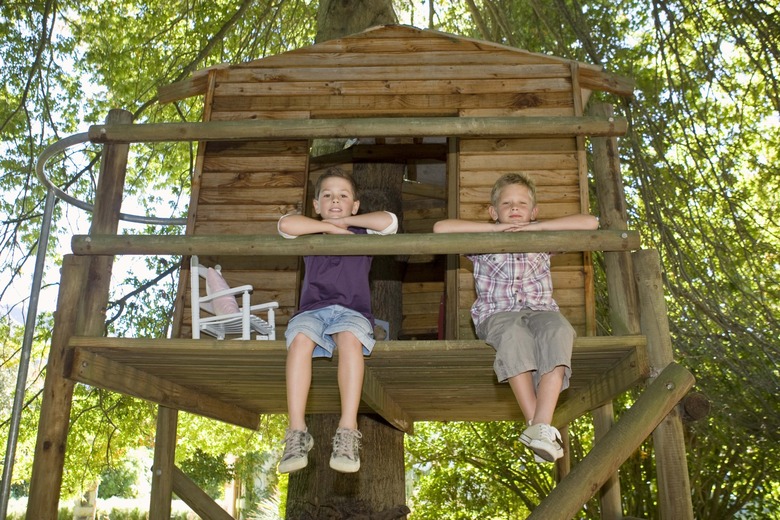How To Build Tree House Rope Bridges
A tree house can provide you with a prime spot to hunt or give your children a great place to play. If you have multiple tree houses, climbing up and down each tree can be a hassle, though. Instead of climbing down one tree to reach the other house, consider making your own rope bridge to connect the two.
Things Needed
- Knife
- Rope
- Measuring tape
- Wooden poles
A tree house can provide you with a prime spot to hunt or give your children a great place to play. If you have multiple tree houses, climbing up and down each tree can be a hassle, though. Instead of climbing down one tree to reach the other house, consider making your own rope bridge to connect the two. A reliable rope bridge is one of the oldest and simplest designs available for bridge construction.
Step 1
Cut out three lengths of thick rope measuring 10 feet longer than the distance between one tree house and the other. This allows for slack between the two tree houses. If you stretch the rope so that there is no slack, it is more likely to break.
- A tree house can provide you with a prime spot to hunt or give your children a great place to play.
- Instead of climbing down one tree to reach the other house, consider making your own rope bridge to connect the two.
Step 2
Lay the long pieces of rope parallel to each other with 5 feet of space between each one. The two ropes on the far sides will make the handholds of your bridge while the center rope will make the foothold where you step.
Step 3
Measure how many feet are in the three lengths of rope. Subtract 3 feet from each side of rope. For every remaining foot of rope, cut two 5-foot lengths of rope.
Step 4
Tie the first 5-foot length of rope to one of your handhold ropes. Tie it 3 feet from the edge of your handhold rope. Make a sturdy knot that you can replicate several times. Stretch the other side of the rope to your center foothold rope. Tie the other half of the 5-foot rope into place on the foothold rope. Tie one side of another 5-foot piece of rope to your foothold rope right next to the first knot. Stretch the end of this 5-foot length of rope to the other handhold rope. Continue to attach the 5-foot segments of rope in this fashion until you are 3 feet from the edge of your long ropes.
- Lay the long pieces of rope parallel to each other with 5 feet of space between each one.
- Tie the first 5-foot length of rope to one of your handhold ropes.
Step 5
Install two 5-foot-tall wooden poles spaced 5 feet apart on each tree house. Place the poles so that your rope bridge will stretch in a straight line from one tree house to the other. Depending on the direction your tree houses face, you may need to install the wooden poles at the entrance of the tree houses or at one of the sides of the tree houses. Install a third wooden pole that is only 4 inches tall. Center the 4-inch wooden pole between the 5-foot poles.
Step 6
Carve grooves into each wooden pole. The grooves need to make a ring around the pole. On the 5-foot-tall wooden poles, make the grooves 4 inches from the top. On the small pole, make the grooves 2 inches from the top. Make the grooves relatively deep and about the width of the rope you used for the bridge.
- Install two 5-foot-tall wooden poles spaced 5 feet apart on each tree house.
- On the small pole, make the grooves 2 inches from the top.
Step 7
Wind the loose rope on each side of your rope bridge around the wooden poles. Attach the handhold ropes to the 5-foot-tall wooden poles and the foothold rope to the 4-inch-tall wooden pole. Use the grooves to hold the rope more securely. Tie the rope into place with a sturdy knot. When you finish, your rope bridge should have a distinct "V" shape.
Tip
Test your bridge from a low location before you use it in a high location. This allows you to safely test your weight on the bridge without the fear of falling a significant distance. Use rope that is at least 1 inch thick to make your rope bridge sturdy.
Warning
The middle pole will present a tripping hazard. Use caution when you step onto or off your rope bridge.
